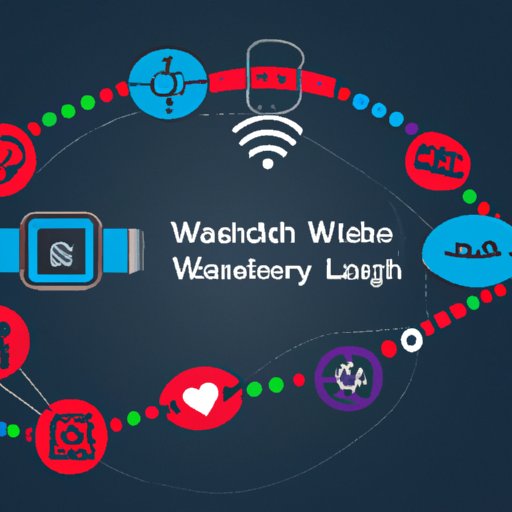Introduction
Wearable technology, also known as “wearables” or “wearable gadgets,” is a category of electronic devices that are designed to be worn on the body. This includes items such as smartwatches, fitness trackers, augmented reality glasses, and other similar products. While wearables have been around for decades in the form of hearing aids, pacemakers, and other medical devices, they have become increasingly popular in recent years due to advancements in technology and an increased focus on health and wellness. In this article, we will explore what wearable technology is, its benefits, challenges, and its impact on healthcare and the workplace.
Exploring the Basics of Wearable Technology
What is wearable technology? Simply put, it is any device that is designed to be worn on the body, usually for the purpose of tracking health and fitness data. This can include everything from fitness trackers to smartwatches, from augmented reality glasses to medical devices. The aim of these devices is to make our lives easier by providing us with easy access to data and information that can help us make better decisions.
How does wearable technology work? Most wearables rely on sensors that detect changes in the environment and then use this data to provide feedback to the user. For example, a fitness tracker might measure your heart rate and then provide you with an estimate of the calories you’ve burned during a workout. Smartwatches may also use sensors to detect changes in the environment, such as temperature or humidity, and then provide you with notifications based on this information.
What are the benefits of wearable technology? There are many advantages to incorporating wearables into our daily lives. Wearables can provide us with real-time data that can help us make better decisions and achieve our goals. They can also help us stay connected with our friends and family, as well as monitor our health and fitness levels. Additionally, they can provide us with enhanced security and privacy, allowing us to keep our personal data safe from prying eyes.

The Benefits of Incorporating Wearable Tech into Everyday Life
Increased convenience and efficiency: Wearable technology can make our lives easier by providing us with easy access to data and information. By using a wearable device, we can quickly check our emails, texts, and social media accounts without having to pull out our phones. We can also use wearables to monitor our health and fitness levels, which can help us stay on top of our goals and make better decisions about our lifestyle.
Improved health and wellness: Wearables can provide us with real-time data that can help us make informed decisions about our health and fitness. For example, a fitness tracker can measure our heart rate and provide us with an estimate of the calories we’ve burned during a workout. Wearables can also help us stay motivated by providing us with reminders to exercise or encouraging messages when we reach our goals.
Enhanced security and privacy: Wearables can provide us with enhanced security and privacy, allowing us to keep our personal data safe from prying eyes. For example, many wearables now come with biometric authentication, such as fingerprint scanners, that allow us to securely unlock our devices. Additionally, wearables can be used to store passwords and credit card information, making it more difficult for hackers to gain access to our sensitive data.
Wearable Technology and Its Impact on Healthcare
Increased access to medical care: Wearable technology has the potential to revolutionize healthcare by providing patients with increased access to medical care. Wearables can be used to track vital signs and provide real-time data that can be used to diagnose and treat conditions. Additionally, they can be used to monitor chronic conditions and provide remote monitoring and management of patient health.
Improved diagnostics and treatment: Wearables can provide doctors with real-time data that can be used to diagnose and treat conditions more quickly and accurately. Additionally, wearables can be used to monitor the effectiveness of medications and treatments, allowing doctors to adjust dosages and treatments as needed.
Remote monitoring and management of chronic conditions: Wearables can be used to remotely monitor and manage chronic conditions such as diabetes, hypertension, and sleep apnea. This can help patients stay on top of their health and reduce the need for frequent visits to the doctor.

Examining the Pros and Cons of Wearable Technology
Pros:
1. Increased productivity: Wearables can increase productivity by providing us with easy access to data and information. This can help us stay on top of our goals and make better decisions about our lifestyle. Additionally, wearables can automate tasks, such as sending emails or scheduling appointments, saving us time and effort.
2. Improved quality of life: Wearables can help us lead healthier, happier lives by providing us with real-time data that can help us make better decisions about our health and fitness. Additionally, wearables can help us stay connected with our friends and family, allowing us to stay in touch even when we’re apart.
3. Reduced cost of healthcare: Wearables can reduce the cost of healthcare by providing doctors with real-time data that can be used to diagnose and treat conditions more quickly and accurately. Additionally, wearables can help reduce the need for frequent visits to the doctor, resulting in lower medical bills.
Cons:
1. Potential for data misuse: Wearables can collect large amounts of data about our health and lifestyle, which can then be misused by third parties. For example, insurance companies could use this data to deny coverage or raise premiums. It is important to be aware of how your data is being used and take the necessary steps to protect it.
2. Risk of injury or infection: Wearables can pose a risk of injury or infection if not used properly. For example, fitness trackers that measure heart rate can cause skin irritation if worn for too long. It is important to follow the instructions provided by the manufacturer and take regular breaks when wearing a wearable device.
3. Lack of standardization: Wearables can vary greatly in terms of functionality and usability. It is important to do your research before purchasing a wearable device to ensure that it meets your needs and is compatible with your existing devices.
A Look at the Future of Wearable Technology
Autonomous wearables: Autonomous wearables are devices that can interact with the environment without direct input from the user. These devices can be programmed to respond to cues from their environment, such as detecting changes in temperature or humidity, and then providing the user with notifications or alerts based on this information. Autonomous wearables have the potential to revolutionize our lives by simplifying everyday tasks.
Smart clothing: Smart clothing is clothing that has been integrated with sensors and other electronic components. This technology can be used to monitor health and fitness data, as well as provide feedback to the user. Smart clothing can also be used to provide additional features, such as climate control or audio playback, making it a great option for those looking to stay comfortable and connected.
Augmented reality: Augmented reality (AR) is a technology that overlays digital content onto the real world. Wearable AR devices, such as glasses or headsets, can be used to provide users with real-time information about their environment. For example, AR glasses can be used to display directions to a destination or provide information about landmarks. AR can also be used to enhance entertainment experiences, such as watching movies or playing games.

How Wearable Technology is Changing the Workplace
Improving safety and efficiency: Wearables can be used to improve safety and efficiency in the workplace. For example, wearable devices can be used to monitor employees’ health and alert them if they are at risk of injury or illness. Additionally, wearables can be used to automate tasks, such as sending emails or scheduling meetings, saving employers time and money.
Enhancing communication: Wearables can be used to enhance communication between employees. For example, smartwatches can be used to send messages and notifications, allowing employees to stay in touch even when they’re apart. Additionally, wearables can be used to facilitate virtual meetings, allowing teams to collaborate more effectively.
Automating tasks: Wearables can be used to automate mundane tasks, such as filling out paperwork or entering data. This can help reduce errors and save employers time and money. Additionally, wearables can be used to monitor employee productivity, allowing employers to identify areas where improvements can be made.
Conclusion
Wearable technology has the potential to revolutionize our lives by providing us with easy access to data and information. Wearables can help us stay connected with our friends and family, monitor our health and fitness levels, and automate mundane tasks. Additionally, they can provide us with enhanced security and privacy, allowing us to keep our personal data safe from prying eyes. Wearables can also be used to improve safety and efficiency in the workplace, enhancing communication and automating tasks. As technology continues to evolve, we can expect to see more innovative uses of wearables in the future.
(Note: Is this article not meeting your expectations? Do you have knowledge or insights to share? Unlock new opportunities and expand your reach by joining our authors team. Click Registration to join us and share your expertise with our readers.)
